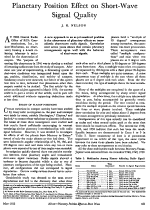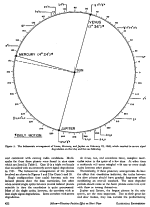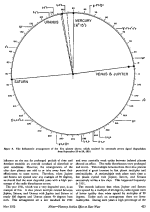|
Part III
Hubble's New "Runaway Planet"
- A Unique Opportunity for Testing the Exploding
Planet Hypothesis and Hyperdimensional Physics -
Which returns us to the Sun.
There is a very well-known, long-period, and still mysterious
variability associated with the largest "hyperdimensional gate" in
our own neighborhood -- our "local" star, the Sun.
Its complex changes, which include a host of related surface
phenomena -- solar flares, coronal disturbances, mass ejections,
etc. -- is termed "the sunspot cycle" ... because the number of
simultaneous "spots" (lower-temperature vortices appearing "dark"
against the hotter solar surface, as this activity occurs -- left)
waxes and wanes over about 11 years.
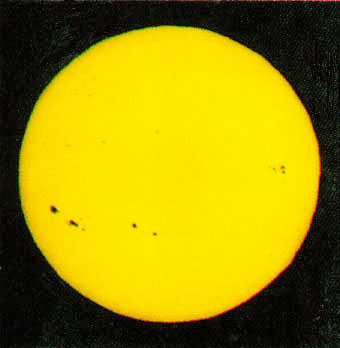
(The full magnetic reversal of
the Sunís polarity takes two complete sunspot cycles to return to
"zero" -- thus the complete "solar cycle" is about 20 years.)
In the 1940ís, the Radio Corporation of America (RCA) hired a young
electrical engineer -- John Nelson -- in an effort to improve the
reliability of HF ("short-wave") radio communications around Earth.
Such radio transmissions had been observed to be, for some reason,
more reliable in the "lulls" in between, than during solar activity
associated with "peak" sunspot years.
To his surprise, Nelson soon specifically correlated this rising and
falling radio interference with not only sunspot cycle, but with the
motions of the major planets of the solar system; he found, to his
increasing astonishment, a very repeatable -- in essence,
astrological correlation ... between the inexorable orbits of all
the planets (but especially, Jupiter, Saturn, Uranus and
Neptune --
which, remember, hold essentially all the solarís systemís known
angular momentum) ... and major radio-disturbing eruptions on the
Sun!
The Hyperdimensional Model finally provides a comprehensive
theoretical explanation -- a "linking mechanism" -- for these, to a
lot of astronomers, still embarrassing decades-old RCA observations.
For, in essence what John Nelson had rediscovered was nothing short
of a "Hyperdimensional Astrology" -- the ultimate, very ancient, now
highly demonstrable angular momentum foundations behind the real
influences of the Sun and planets on our lives ...
(click below image)
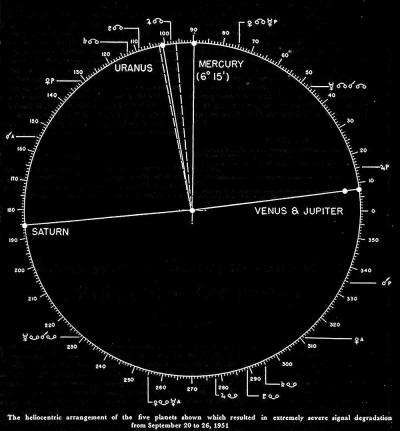
For, as part of his solar research, Nelson also "rediscovered"
something else ...
"It is worthy of note that in 1948
when Jupiter and Saturn were spaced by 120 degrees, and solar
activity was at a maximum, radio signals averaged of far higher
quality for the year than in 1951 with Jupiter and Saturn at 180
degrees and a considerable decline in solar activity. In other
words, the average quality curve of radio signals followed the
cycle curve between Jupiter and Saturn rather than the sunspot
curve ... [emphasis added]."
-- J.H. Nelson
"Planetary Position Effect on
Short-Wave Signal Quality" (click
below images)
(Electrical Engineering, May 1952)
These decades-old observations are very
telling ... not only confirming Jupiter and Saturn as the
primary
"drivers" behind the Sunís known cycle of activity (in the HD
Model), but strongly implying an additional direct effect of their
changing angular relationship on the electrical properties of
Earthís ionosphere. This, of course, is totally consistent with
these changing planetary geometries affecting not just the Sun, but
the other planets as well ... just as "conventional" astrologers
have claimed -- via Maxwellís "changing scalar potentials"...
Therefore, at this point, only the hyperdimensional theory--
1) Points to the (literally!)
deepest implications of the simple astronomical fact that the
"tail wags the dog"-- that the planets in this physics are fully
capable of exerting a determinant influence on the Sun -- and
each other -- through their disproportionate ratio of total
solar system angular momentum ... over 100 to 1, in the [known!]
planetsí favor.
2) Only the Hyperdimensional Model, possesses the precise physical mechanism -- via
Maxwellís "changing quaternion scalar potentials" -- accounting
for this "anomalous" planetary angular momentum influence.
3) And, only the HD theory, has already publicly identified, at the United
Nations, in 1992, a blatant geometric clue to this entire HD
solar process: the maximum sunspot numbers (those large,
relatively "cool," rotating vortices appearing on the solar
surface), rising and falling and methodically changing latitude,
during the course of the familiar 22-year solar cycle--
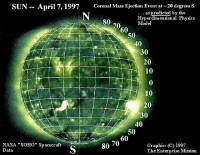 And peaking every half-cycle (~11 years), at the
hyperdimensionally-significant solar latitude of ~ "19.5
degrees!" (click image left) And peaking every half-cycle (~11 years), at the
hyperdimensionally-significant solar latitude of ~ "19.5
degrees!" (click image left)
Furthermore, recent discoveries via the
indirect technique of "helioseismology" (optical monitoring of sound
waves vibrating back and forth within the Sun), have revealed
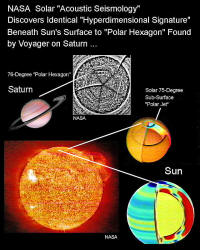 another clear solar "hyper-dimensional signature at play; a curious
"jet," flowing around the north pole several thousand miles below
the visible solar surface; the remarkable similarity to an
equivalent phenomenon discovered by Voyager flowing around the
north
pole of Saturn -- a "polar hexagon"
(click image right) in the clouds -- even to the
latitude, seems just a bit "too coincidental." another clear solar "hyper-dimensional signature at play; a curious
"jet," flowing around the north pole several thousand miles below
the visible solar surface; the remarkable similarity to an
equivalent phenomenon discovered by Voyager flowing around the
north
pole of Saturn -- a "polar hexagon"
(click image right) in the clouds -- even to the
latitude, seems just a bit "too coincidental."
Unfortunately, because the discovery is not based on direct imaging
(as with Voyager), but on an indirect "sub-surface flow" technique,
the investigators have rounded off the corners of the potential
sub-surface "solar hexagon"; in fact, they should consult more
frequently with their NASA planetary colleagues for additional
examples of this geometric, now clearly hyperdimensional "flow
pattern" elsewhere in the solar system...
The increasing identification of the hyperdimensional mechanism
underlying the Sunís primary energy production has, unfortunately,
brought with it certain inevitable, potentially disquieting
predictions ...
Described first by Kepler as his "Third Law," the farther out a
planet orbits from its star the longer is its period of revolution.
Since weíre talking about possible additional planets driving this
entire Hyperdimensional Solar Process (see again angular momentum
diagram, above) -- planets that must be hundreds of times farther
from the Sun than Earth (Pluto is "only" 40 times its distance, and
orbits in "only" about 250 years) -- the "years" of these
extremely
distant worlds could equal thousands if not tens of thousands of
Earthís year ... depending on their orbits. Because of these immense
orbital periods, the cycles of solar energy production driven by
their combined angular momentum will also be v-e-r-y long, indeed...
perhaps as long as ~26,000 years ... (remember that number).
Also remember that such distant planets -- even if not particularly
massive -- will have a disproportionately large effect on the total
solar HD energy generation, because of the enormous "leverage" in
the angular momentum equation with increasing distance. Thus, these
still undiscovered worlds must in fact account for most of the solar
energy we see ... depending on the actual orbital periods; the
repeated ultra-long-term phasing of their orbits -- creating
equally long-term angular momentum resonances in the Sun -- must
produce resulting long-term cyclic changes in the Sunís total
luminosity ... lasting literally thousands of years ... far longer
than the short-term, historical "sunspot cycle" Nelson first linked
directly to the known members of the solar system.
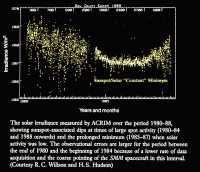 There is already a well-known link, between the historical
11-year
"sunspot cycle" -- increased solar flares, x-ray emission, frequency
of "coronal mass ejections," etc. -- and a measurable (if
inexplicable as yet) increase in total solar energy production.
Misnamed "the solar constant" (click
image left), this cyclic increase and decrease
(according to satellite measurements) is curiously in phase with the
current sunspot cycle ... averaging about 0.15%. There is already a well-known link, between the historical
11-year
"sunspot cycle" -- increased solar flares, x-ray emission, frequency
of "coronal mass ejections," etc. -- and a measurable (if
inexplicable as yet) increase in total solar energy production.
Misnamed "the solar constant" (click
image left), this cyclic increase and decrease
(according to satellite measurements) is curiously in phase with the
current sunspot cycle ... averaging about 0.15%.
This NASA-documented short-term variation of the entire Sun, is now
directly traceable (in the HD Model) to the changing geometric phase
relationships between the solar systemís two largest known planets,
Jupiter and Saturn (as Nelson long ago confirmed); their orbital
conjunctions -- when both worlds return again to the same geometric
position, relative to one another -- take place on average roughly
every 20 years ... the mean of the full "magnetic" solar cycle! (At
the "half cycle" -- the familiar 11-year sunspot period itself --
Jupiter and Saturn are, of course, 180 degrees out of phase ... a
critical clue to the determinate, modulating hyperspatial geometry
actually inherent in this process ...)
But, if the known changes in solar output are due to
hyperdimensional effects of the largest known planets, what of the
magnitude of "aether stress" produced by our proposed "new planets"
-- with angular momentum contributions hundreds of times greater?;
the long-term cyclic increase in solar energy created by those
cyclic phasings (yet-to-be-experienced in
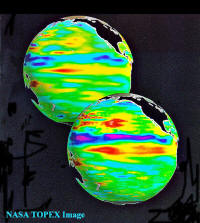 recorded history ...)
could measure as much as several percent above current solar output. recorded history ...)
could measure as much as several percent above current solar output.
This is more than enough additional energy -- even without Mankindís
current addition of significant "greenhouse gasses" to the
atmosphere -- to trigger profound, millennia-long climatic changes
here on Earth..., including ... melting ice caps; rising ocean
levels; dramatic changes in jet stream altitudes and activity;
increased tornado intensities; increased hurricane wind velocities
... and..., a permanent "El NiŮo" (whose warmest waters, satellites report, are
at ... ~19.5 degrees). (click image right)
And thatís saying nothing about HD energy added to the internal
workings of our planet... from all indications, we are now well into just such a new,
long-term, cyclic solar period ... just as the HD Model has
predicted. The implications should be obvious.
Enter once more, Susan Terebey.
With the discovery and official NASA announcement of
Dr. Terebeyís
"new planet" -- a "Jovian-type" world 450 light years away ... yet,
in apparent total isolation -- we have the perfect conditions for a
new series of crucial tests of the "Hyperdimensional Model,"
starting wit:
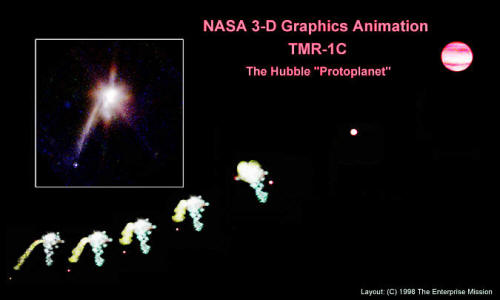
1) Systematic spectroscopic
observations (carried out over days or months), to detect the
presence of any satellites of this proposed Jovian-type world.
Curiously, this possibility has not even been alluded to in any
of the official NASA presentations on this object (see NASA
artistís depiction - click above image).
It is almost inconceivable that such a giant world could have
formed without multiple orbiting satellites; just look at the
"miniature solar systems" of moons orbiting the major planets of
this solar system ...
Confirmation of such additional objects would in itself be
another major scientific "first." But, in this case, it would
also have far deeper implications; some of those same moons
could have considerable mass themselves -- perhaps as much as
Mars ... or even Earth ... depending on the parent planetís
mass. The latter could, in fact, be independently determined
(via appropriate application of "Keplerís Laws") through
physical detection of such moons and determining their orbital
periods. This would then provide a completely independent
calibration of the accuracy of the "primary objectís" currently
estimated mass -- derived, as Terebeyís freely admits, solely
from theoretical "cooling curves" (see above) and the "new
planetís" measured IR luminosity itself.
These additional remarkable objects (if they exist ...) should
be detectable with a variety of present astronomical
technologies -- including Hubble -- provided someone looks.
 [And, confirmation of truly massive satellites (a "Mars" or
"Earth") circling this new "potential planet" could vindicate,
in a stroke, a major piece of Van Flandernís own revolutionary
model -- that our own Mars (if not a number of other objects)
once orbited a larger planet in this solar system as satellites
(click image left)... until all (including Mars) were released by the catastrophic
explosion of that "parent world." [And, confirmation of truly massive satellites (a "Mars" or
"Earth") circling this new "potential planet" could vindicate,
in a stroke, a major piece of Van Flandernís own revolutionary
model -- that our own Mars (if not a number of other objects)
once orbited a larger planet in this solar system as satellites
(click image left)... until all (including Mars) were released by the catastrophic
explosion of that "parent world."
Van Flandern, one of the worldís leading celestial mechanics
experts, has calculated the probable orbital parameters of such
an extraordinary event -- and has reached the conclusion that
Marsí uniquely elliptical path around the Sun (of all the inner
planets) is highly consistent with its "escape" from such a
"missing," former member of the solar system ...]
Successful detection of a "Mars" or "Earth" (or any significant
satellites) orbiting Susan Terebeyís "new planet" would
immediate present possibilities for carrying out the same
variety of HD tests proposed (above) for the outer planets of
this solar system, starting with...
2) Detection of distinct variations in the "new planetís"
own infrared emissions -- synchronized with the calculated
orbital periods of any detected satellites (or resonances
thereof ...). This would offer immediate, compelling evidence
for the general correctness of the "Hyperdimensional Model" ...
especially, if such IR signatures could be matched with similar
types of time-varying emissions observed radiating from the
giant planets of this solar system ...
Such confirmations would provide crucial and timely evidence
supporting the basic correctness of the "HD Model."
Equally important, if such confirmations are forthcoming, the
extraordinary possibility will be further enhanced that this
same fundamental physics, in our own solar system, could ... and
has... destroyed entire worlds ...
For those who need a "practical" reason to address these issues,
consider this:
Understanding the conditions under
which these types of "epochal events" could come to pass ... and
if, through proper understanding and control of "HD Physics,"
they can be averted for our planet ... would seem a simple,
basic rationale for renewed interest in what Maxwell really
stated. Given the demonstrable, historically-unprecedented
changes currently occurring in our own environment -- from
mysteriously-rising geophysical and volcanic activity (some of
the most significant now occurring at that suspicious "19.5
degrees!"), to increasingly anomalous climatological and
meteorological activity (does anyone notice that hurricanes have
always been born at an average latitude of ...19.5 degrees?) --
verifying the effects of a changing "hyperdimensional physics"
in our own neighborhood is far from being "merely academic."
Then, of course, there are the
continuing, dramatic changes in the Sun...
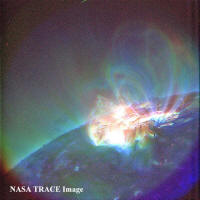 Immediate solar predictions of the
HD Model are simple and quite
clear: increasingly violent average solar surface activity
(click image right) --
modulated with the rising and falling with the familiar "sunspot
cycle" of ~11 years (cycle #23 should be a "lulu!") -- taking place
against a backdrop of equally dramatic, long-term rising of total
solar energy emission. Immediate solar predictions of the
HD Model are simple and quite
clear: increasingly violent average solar surface activity
(click image right) --
modulated with the rising and falling with the familiar "sunspot
cycle" of ~11 years (cycle #23 should be a "lulu!") -- taking place
against a backdrop of equally dramatic, long-term rising of total
solar energy emission.
The major unknown is the overall effect of this slowly increasing
"HD energy" availability throughout the entire solar system; for,
remember, the changing "aether stress" is not localized inside stars
or planets; these concentrations of "matter" merely allow us to
trace the visible effects -- like red dye in clear water -- of these
underlying, changing "hyperspatial strains." Thus, the overall
dynamical effect of the Earthís own significant (to us!) angular
momentum interaction with this changing solar system physics --
including its own long-term, "higher order rotation," the ~26,000
year precessional cycle and the mysterious role of the Moon -- is
all still quite uncertain ...
However, recent anomalous observations of perhaps the most
fundamental dynamical parameter of Earth -- its own rotation -- seem
to support this growing perception that "something" indeed is
rapidly changing in the solar system ...
For some inexplicable reason, there has been an accelerating
slow-down of the Earthís spin (click below
image) on its own axis over the last twenty
years -- as measured against electronic transitions of the "Cesium
Atomic Clock," maintained at the National Bureau of Standards, in
Boulder, Colorado.
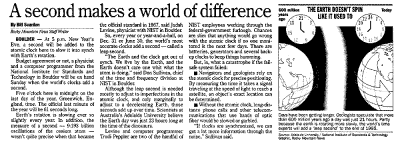
Theoretically stable to "plus or minus one second in a million years
..." the official atomic clocks have literally had to be adjusted by
over 20 seconds in these preceding two decades -- a stunning change
by astronomical standards, and striking confirmation of some kind of
major, "progressive phase-shift" now occurring, between the rotation
of our planet and the atomic-level "constants" that govern the
quantum standards of the Clock. This need to, with increasing
frequency (now, approximately every six months) update a full second
differential between "dynamical time" and "time at the atomic
level," is profound confirmation of some kind of fundamental
coupling between the angular momentum of our own planet, and the
larger changes occurring in the hyperspatial physics of the solar
system ... as outlined in the basic HD Model.
This includes the
possibility that these changing "hyperspatial stresses," due to the
progressive orbital movement of our as-yet-undiscovered "outer
planets" (in the Model) are simply causing increasing "Maxwellian
scalar potential changes" all across the solar system at the atomic
level -- changing (via the "Aharonov-Bohm Effect") all resultant
quantum-level "constants" governing the clocks by small (but
laboratory-measurable) amounts.
If this is true, it could thus be the Clocks themselves that are
also internally changing ... simultaneous with the predicted,
accelerating slow-down in the basic rotation of the Earth!
Additional evidence that "something major" is occurring in the solar
system, is the recent announcement (by three major "world-class"
laboratories) of startling changes in another fundamental physical
parameter -- the Gravitational Constant (click
below image); according to an article
published in "Science News" in 1995, not only has this centuries-old
"constant" been found to differ now from all previous "textbook"
values ... each of the three laboratories reported different changes
... the largest amounting to a whopping (by measurement standards)
0.06%!
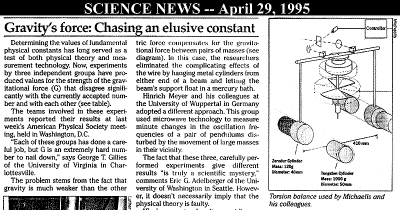
Completely inexplicable by any mainstream theories, such changes are
intrinsically expected (ala
Whittakerís derivation of "electrogravitic"
linkages between gravity and light) in the true Maxwellian analysis
of "varying scalar potentials" of the vacuum. Again: changes
modulated by the changing phase relationships between our proposed
"undiscovered outer planets" in the "total solar system angular
momentum equation."
There is insufficient room to develop here (let alone to document)
all the additional implications stemming from this Model (that will
be done elsewhere). Suffice it to say, this is intrinsically a
changing physics, affecting every known system of astronomical,
physical, chemical and biological interaction differently over time
-- because it affects the underlying, dynamical hyperspace
foundation of "physical reality" itself ... starting with this solar
system; that is implicit in the Model.
And now, according to all accumulating evidence and this
centuries-old physics ... we are simply entering once again (after
"only" 13,000 years ...) a phase of this recurring, grand solar
system cycle "of renewed hyperdimensional restructuring of that
reality ..."
It is for these basic reasons that NASA must now openly -- and
rapidly -- carry out these recommended new observations of the solar
system, including additional, detailed measurements of "TMR-1C"
...
and then immediately tell us the results.
Time is getting short.
Go Back
|


